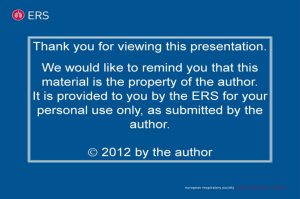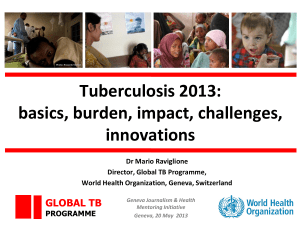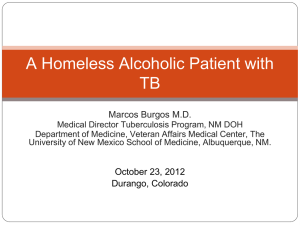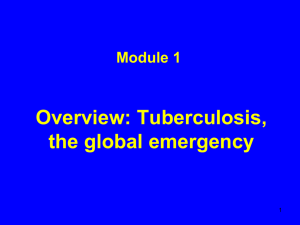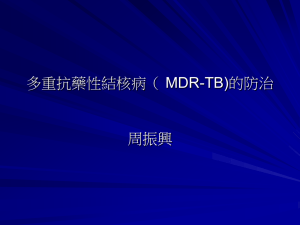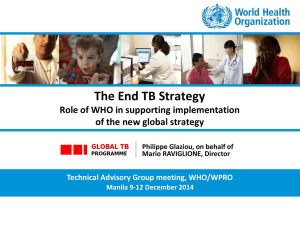Target Audience
advertisement
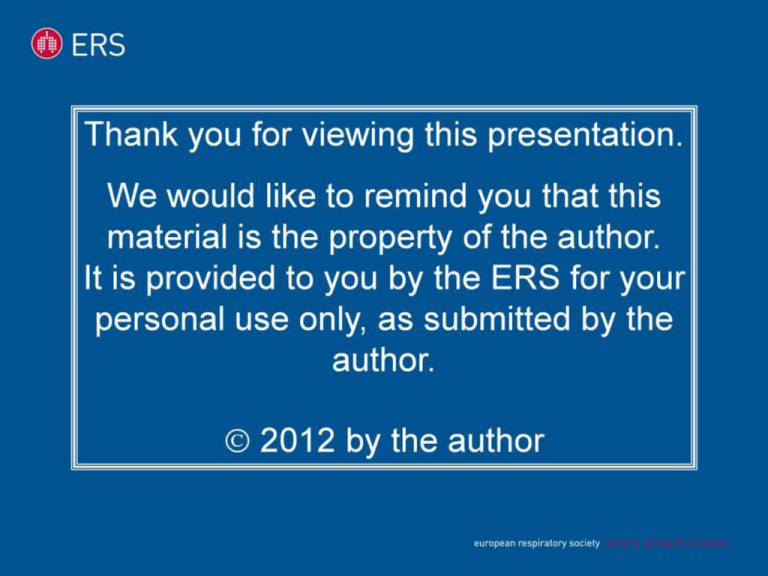
Thank you for viewing this presentation. We would like to remind you that this material is the property of the author. It is provided to you by the ERS for your personal use only, as submitted by the author. 2012 by the author Filling the global training gap Lia D’Ambrosio WHO Collaborating Centre for TB and Lung Diseases, Fondazione S. Maugeri, Tradate, Italy Learning Objectives • To describe the main training opportunities on TB, TB/HIV management & control offered by the international training agencies. • To discuss the global training gap • To identify opportunities to tackle the gap (role and contribution of theTB PAN-NET project) HRD, not training ! HR development need for global health workforce: HRH drives health systems! The STOP TB Strategy – 2010 1. 2. 3. 4. 5. 6. Pursue high-quality DOTS expansion and enhancement a. Secure political commitment, with adequate and sustained financing b. Ensure early case detection, and diagnosis through quality-assured bacteriology c. Provide standardised treatment with supervision, and patient support d. Ensure effective drug supply and management e. Monitor and evaluate performance and impact Address TB-HIV, MDR-TB, and the needs of poor and vulnerable populations a. Scale–up collaborative TB/HIV activities b. Scale-up prevention and management of multidrug-resistant TB (MDR-TB) c. Address the needs of TB contacts, and poor and vulnerable populations Contribute to health system strengthening based on primary health care a. Help improve health policies, human resources development, financing, supplies, service delivery and information b. Strengthen infection control in health services, other congregate settings and households c. Upgrade laboratory networks, and implement the Practical Approach to Lung Health (PAL) d. Adapt approaches from other fields and sectors, and foster action on the social determinants of health Engage all care providers a. Involve all public, voluntary, corporate and private providers through Public-Private Mix (PPM) approaches b. Promote use of the International Standards for Tuberculosis Care (ISTC) Empower people with TB, and communities through partnership a. Pursue advocacy, communication and social mobilization b. Foster community participation in TB care, prevention and health promotion c. Promote use of the Patients' Charter for Tuberculosis Care Enable and promote research a. Conduct programme-based operational research, and introduce new tools into practice b. Advocate for and participate in research to develop new diagnostics, drugs and vaccines The global burden of TB in 2010 Estimated number of cases Estimated number of deaths All forms of TB (men and women) 8.8 million (range, 8.5–9.2 million) 1.1 million* (range, 0.9–1.2 million) All forms of TB (in women) 3.2 million (38%) (range, 3.0–3.5 million) 0.3 million (range, 0.2–0.4 million) 1.1 million (13%) (range, 1.0–1.2 million) 0.4 million (range, 0.32–0.39 million) HIV-associated TB Multidrugresistant TB 0.65 million** ~ 0.15million *excluding deaths among HIV+ people ** prevalent cases Incidence of TB per 100,000 population, 2010 8 Proportion of MDR among new TB cases, 1994-2010 Estimating the global international training needs • Programmatic needs: 200 countries*/territories/entities x 5 persons/yr in average=1,000 persons/yr; • Clinical needs: 2-3 times higher *WHO Member States: 194 Search strategy Major established mono-thematic courses on TB and TB/HIV Organized by International Organizations (WHO,IUATLD, CDC, KNCV, FILHA, ERS, ATS etc..) Duration: > 3 days Exclusion criteria: e-learning, PGs at Conferences, Formal trainings included in Academic degrees (PhD, MPH, etc..) At the moment Several epidemiological trainings (CDC, The Union) 1 managerial based on STB Strategy (Sondalo, Italy) covering MDR-/XDR-TB, TB/HIV and IC Several mixed ones with regional focus (FILHA, KNCV, AFRO, JICA) Few MDR courses (clinical) and IC ones Many under PG format (< 1week) Majority without validated and standardised materials Search criteria for assessment Aims Target audience Topics Training Methodology Duration Max number of participants FILHA Courses: Tartu & Tallin, Estonia 4 formats, short duration: • 1) Today's Challenges in Tuberculosis Control • 2) International training Course on Tuberculosis for Nurses • 3) International Training Course on Tuberculosis control • 4) Training Course on Tuberculosis Infection Control 1) Today's Challenges in Tuberculosis Control • Aims: to improve, to update the knowledge and skills of medical specialists in addressing the changing challenges in TB control in the Region • Target audience: medical doctors (pulmonology, infectious diseases, public health) and professionals working in TB • Topics: epidemiology, surveillance, diagnostic methods, laboratory issues, infection control, screening and treatment of latent TB infection, new innovations in TB management and control, diagnosis and treatment of MDR-TB, XDR-TB and TB/HIV co-infection. • Training Methodology: interactive with lectures, discussions and group sessions based on exercises and case studies. Site visits to the TB and MDR-TB wards and National TB Register. • Duration: 4 days; Max number: not specified 2) Training Course on TB for Nurses • Aims: to strengthen nurse’s role and tasks in TB prevention, diagnosis, treatment and infection control in the Region, improving cognitive, technical and communication skills needed in TB management. The course covers both theoretical and practical aspects of TB management from a nursing perspective. In addition, the course serves as a training-of-trainers event (ToT) • Target audience: nurses involved in TB control activities (outpatient or inpatient settings), in the civilian and prison sectors in those regions that are presently implementing the DOTS or DOTS+ strategy. • Topics: based on the training modules originally provided by CDC, revised and adapted for local circumstances and translated into Russian (epidemiology, basic principles of a national TB control programme, TB prevention, diagnosis, treatment and infection control.) • Training Methodology: focus on real-life problems, lectures, discussions and group sessions based on case studies and exercises. Site visits to the TB and MDR-TB wards and National TB Register. • Duration: 5 days, Max N°: 25 pp 3) International Training Course on Tuberculosis Control • Aims: to enhance capacity for clinical and managerial decision making in TB control in the WHO European Region with special emphasis on Eastern Europe • In collaboration with: NTP of Estonia, the Tartu University Clinics, IUATLD & WHO • Target audience: physicians with clinical experience of TB, intermediate/ high-level management responsibilities in TB control from national and regional TB Control programmes, Red Cross, other NGOs, penitentiary care and general health care. • Topics: diagnosis, treatment and management of TB, MDR/XDR-TB and TB/HIV co infection. Overview of the epidemiological situation regarding TB and HIV in the region, surveillance of TB, role of laboratory in diagnosis and follow up of TB, infection control, drug management, experiences in implementation of DOTS+ project, cooperation among different actors and questions of adherence, substance abuse and human resources. • Training Methodology: interactive with lectures, discussions and group sessions based on exercises and case studies and site visits to the TB and MDR-TB hospital ward • Duration: 8 days; Max N°: not specified 4) Training Course on TB Infection Control • Aims: to improve the technical capacity to assess, plan, implement and evaluate TB-IC measures in health facilities to strengthen regional TB control programmes • Target audience: physicians, nurses and technical (IC equipment maintenance, ventilation) staff involved in TB control activities from civil and penitentiary settings, HIV/AIDS services and general health care, staff involved in regional infection control planning and implementation or training of health professionals • Topics: principles related to TB-IC strategy, health facility TBIC assessment, planning and evaluation. • Training Methodology: lectures, demonstrations, classroom exercises and field exercises in TB wards, in a laboratory and at an outpatient clinic. • Duration: 5 days, Max number: 25 pp The International Union Against Tuberculosis and Lung Disease (IUATLD) courses Provide the knowledge and skills required by healthcare professionals and programme managers to develop public health programmes clinically sound and administratively effective. Training: mix of theory and international best practices, with emphasis on the challenges presented by limitedresource settings. Union courses serve the needs of participants from various disciplines Work at different levels, and in diverse environments Content adapted either for international or national groups. IUATLD courses Technical Courses (english/french/spanish) International Course on Clinical Management of DrugResistant Tuberculosis (Bankok) International Tuberculosis Course (Arusha, Hanoi): epidemiological Health Management Training Courses The Union’s International Management Development Programme (IMDP) Other technical courses Working Together – Strengthening the Implementation of Collaborative TB/HIV Activities Course in operational research Courses offered on request International Course on Clinical Management of Drug-Resistant Tuberculosis, Bangkok • Aims: To provide knowledge and skills to effectively manage cases of drug-resistant TB, especially MDR-TB. To introduce to the challenges by XDR-TB and the approach to treatment of drug-resistant TB from a programme perspective. • Target audience: clinicians working in low income settings • Topics:. clinical and programmatic management of drugresistant tuberculosis MDR-/XDR-TB • Training Methodology: 5-day interactive course, class presentations, discussions & practical exercises Max N: 30 pp International Tuberculosis Course (Arusha, Hanoi) • Aims: to provide: the key elements of TB control theory basis for management of NTP under field conditions • Target audience: clinicians working in high-burden settings • Topics:.clinical and programmatic management of drugresistant TB MDR-/XDR-TB • Training Methodology: lectures and discussions, practical field experience in the sputum microscopy laboratory, at the district tuberculosis centre and in the hospital. Health Management Training Courses • Organized by The Union’s International Management Development Programme (IMDP), created to train leaders in public health with essential skills necessary for managing effective health programmes (management education). • Target audience: health professionals workers operating a national health programme • Topics: Strategic Planning, Mass Media & Communications, Budget and Financial Management, Project Management, Networking and Partnership, Leadership, Human Resources Supply-Chain Management • Training Methodology: lectures, role-plays, work simulations, critical questions and effective solutions, real-life situations and in-class discussions, techniques for relationship and coalition building Course on Operational Research •Three 5-day modules spaced out over 9 months. •Aims: to develop the practical skills for conducting and publishing operational research. Development of a personal research protocol Data collection and set up an electronic system for data entry and analysis Write and submit a scientific paper to an international peer-reviewed journal Courses upon request: TB/HIV Collaborative Activities • • • • Course offered upon request from both NAP and NTP of the country programmes Aims: to strengthen the country-level implementation of collaborative TB HIV activities from the point of view of both the HIV and TB programmes to develop a collaborative TB HIV action plan using measurable indicators from the Global Plan to Stop TB Target audience: National AIDS and TB Programme Managers,TB HIV focal persons for NTP, WHO National TB HIV Programme Officers Course follow-up: Participants can submit abstracts on their outputs for the IUATLD Conference and be considered as invited speakers atn the special NTP/NAP symposium Duration: 4-1/2 day Max N°: not specified Others courses upon request • Intensive Course in Tuberculosis for Medical Specialists • Intensive Course in Tuberculosis for University and Medical School Faculty • Intensive Course in Clinical Management of Patients with Drug-Resistance • Management of Asthma • Management of Tuberculosis in Children Centres for Disease Control and Prevention (CDC) Division of Tuberculosis elimination Atlanta, USA • Continuing Education Activities • Regional Training & Medical Consultation Centers • TB Education & Training Network • Find TB Resources. org • TB Education and Training Resources Website, Searchable database Continuing Education Activities Free of charge, 6.5 hours of instruction, exam, course evaluation, CE certificate. Self Study Modules on Tuberculosis (Modules 1-9) Webinars – Web-based course Continuing Education Credits Self Study Modules on Tuberculosis • Information about TB in a self-study format • Basic information on TB: modules 1-6 • Specific TB programmatic information (Continuing Education): modules 7-9 Web-based course Continuing Education Multidrug-Resistant Tuberculosis (MDR-TB) and Extensively-Drug Resistant (XDR)-TB (with a joint sponsorship with other USA TB Centres) • Target Audience: State and local TB program staff and other clinicians who diagnose and treat TB • Topics: epidemiology of MDR and XDR-TB, diagnosis, treatment of MDR and XDR TB, contact management TB Education and Training Network To network, share resources, and build education and training skills. Provide updated information about TB courses and training initiatives Membership: representatives from TB programs, hospitals, nursing homes, federal agencies, universities, the American Lung Association, Regional Training and Medical Consultation Centers, international organizations interested in TB education and training Find TB Resources: the TB education & training resources website (www.findtbresources.org) KNCV Tuberculosis Foundation Regional Training onTuberculosis Control Programme Management (Riga, Latvia) Aims:to improve TB management skills in: Programme planning Human resource management Finance management Laboratory support Strengthening partnership and team building Surveillance Monitoring and Evaluation Target Audience: Senior staff involved in TB control in the WHO European region countries Duration: 8 days Max. N: not specified Japan International Cooperation Agency, JICA Independent governmental agency,providing: technical assistance programs/projects for capacity and institutional development assisting economic and social growth in developing countries promotion of international cooperation. JICA trained more than 1500 participants from over 70 countries since1963. Technical training program: Technical field-Country/Region-specific courses for participants from the developing countries Target Audience: senior technicians, medical doctors responsible for the management of laboratory works in TB control program, medical officers responsible for implementing the NTP. Duration: from 3 weeks to 1 year Max number: 4 -15 pers JICA’s courses on TB control Aims: To assist countries with high number of TB patients, high incidence rate of TB (assistance to 20 out of 22 high-burden countries) To give priority on the implementation of quality DOTS through developing NTP and laboratory staffs’ capacity for: R&R Laboratory networking Drug management logistics Monitoring onsite visits WHO Collaborating Centre for TB & Lung Diseases, Italy Sondalo courses on Stop TB Strategy (TB, M-XDR-TB,TB/HIV, PPM, IC & more) Aims: to develop the necessary skills to plan, implement and evaluate a TB control programme in the MDR-/XDR-TB era, based on the WHO- recommended strategy, the new “Stop TB Strategy”. Training methodology innovative centred on a Fictitious Country • • • • • • • • • To plan and co-ordinate the mission with WHO/ Contracting Agency, local authorities and partners To review data on the key components of NTP based on the new Stop TB Strategy Analyse and synthesise the main findings, identify priorities, propose solutions and develop recommendations Write a report including key information and recommendations relevant for present or future activities according to the Contracting Agency needs and the kind of mission Debrief local staff and partners on the main mission’s findings and recommendations. Submit the report to the Contracting Agency for finalisation and planning of further actions/steps Design a plan on MDR-/XDR-TB control and implementation of TB/HIV activities Manage different steps of a GFATM proposal Calculate ACH (Air Changes per Hour) in different rooms and identify priorities for infection control (with focus on high MDR-TB and HIV prevalence settings) Target Audience: key-staff of National TB Programmes, WHO and Partners officers and Donors managers of TB/MDR-TB and HIV programmes at the national or sub-national level or staff involved in control programmes (Ministry of Health staff, staff of international agencies involved in TB/MDR-TB/HIV control, leading national experts and opinion-leaders involved in TB/MDR-TB/HIV prevention, diagnosis and care) Coverage: 50% of national central unit staff globally from all the 22 high-burden countries, all the European WHO Region countries and the majority of countries from all continents Sondalo training 10 years, best USAID-funded project 2003-4 Managerial with clinical components Task analysis-based Built on the golden 7 rules Fully practical Measurable outcomes impact (report, recommendations, plan) Emphasis on “capacity to do” Global attendance Standard materials and trained facilitators (ToT) Participant’s, Facilitator’s and Course Director’s manuals Materials updated twice a year Pre-requisite to be registered in the TBTEAM roster Duration: 2 weeks; Max N°: 24 pp Role play Theory Individual plans, reports and recommendations Case study exercise: presentation and problem solving Group exercise, presentation and discussion The 7 golden rules 1. Define the target population for training 2. List the tasks to be performed by the target population on the job (=job description) 3. List the skills and knowledge needed to do the tasks. 4. Organize the selected skills and knowledge into suitable teaching units (modules) and develop the training design (including brief outlines of module content and planned training methods). 5. Draft the teaching units (modules) with learning objectives 6. Expand outlines of modules, including instructional objectives, draft of main body of text and descriptions of training methods, examples and exercises. 7. Draft the complete modules, facilitator guidelines and course director guidelines. ERS TB trainings Coordinated and complementary to Sondalo Within the framework of the ERS School ToT, quality materials Continuous rotation of topics around the Hermes ones Important practical component Balance between clinical and programmatic components Careful evaluation Formats: PGs, External Courses, Seminars, Web Courses, MP Durations: from ½ day to 5 days Web bank of training materials Drawbacks of existing training/materials • • • • • • • Not standardised Not based on Task Analysis Not based on Learning Objectives Clinically-oriented Over-use of frontal lessons Facilitators are not trained Evaluation:reaction evaluation questionnaire/pre-post tests • Facilitators are not coordinated Conclusions • Established major trainings support <400 trainees/yr excluding those trained via web, during conferences and within diplomas (PhD, Masters, etc) • The offer of TB training is far to cover the needs • The TB-PANNET offers a solid platform for integrated training, complementing different initiatives into a larger ERS perspective linking clinicians, public health officers and other professionalities • Your opinions and suggestions will be very important to continue quality improvement and to fine tune future training offers THANK YOU!!

